These 6 Sunglasses Shapes Are Timeless
Choosing sunglasses doesn't have to be difficult!
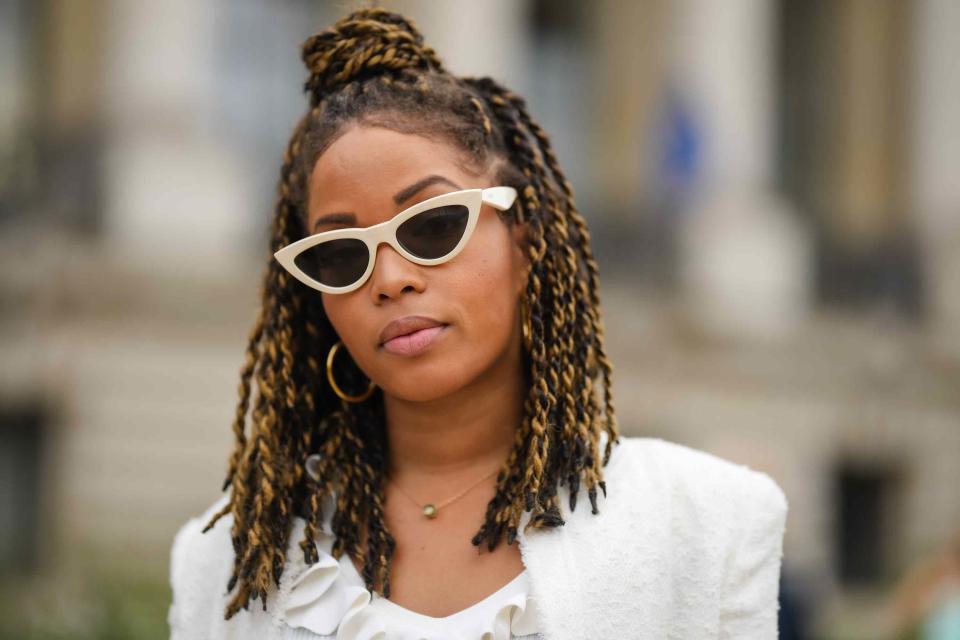
Getty Images
Whether or not you’re obsessed with trendy accessories, live by the beach, or are an outdoor sports fanatic, odds are that you own at least one pair of sunglasses. Sunglasses as we know them have had a long evolution: According to Warby Parker, one of the first direct-to-consumer glasses companies, this often stylish and always practical eyewear can trace its roots back to the dawn of the first millennium(!) and has continued to evolve in form and function throughout the centuries. However, most fashion scholars agree that today’s iteration of sunglasses developed from the tinted lenses that Venetian gondoliers wore while traversing the famous canals in the 18th century.
Modern sunglasses first gained popularity in America in the 1920s with the rise of mass production and greater distribution capabilities. These simple shades featured lightly tinted lenses that were set into simple round or oval frames made of wire and metal and often worn when driving the very first automobiles. By the 1930s, different designs began to emerge, most notably the Aviator style, invented by the U.S., military in 1935, which was quickly followed by the invention of polarized lenses to provide added sun protection for pilots.
Since then, sunglass trends have continued to evolve with both fashion and technology, making it easy to pick out the most popular style of frames from each decade. While Aviator sunglasses are one of the oldest sunglasses still regularly seen today, other styles like the Wayfarer, cat-eye, round, oversized, and wraparound sunglasses are just as popular. To help shed light on what to look for in new sunglasses and how to choose frames that meet both your practical needs and fashionable expectations, we’ve tapped experts Dr. Jennifer Tsai and Natalie Cantell.
Meet Our Expert
Dr. Jennifer Tsai is a board-certified optometrist.
Natalie Cantell is a stylist & creative consultant.
Keep reading for everything you need to know about our favorite types of sunglasses, including their origins, key features, suitable face shapes, and a few shoppable styles we love.
The Aviator
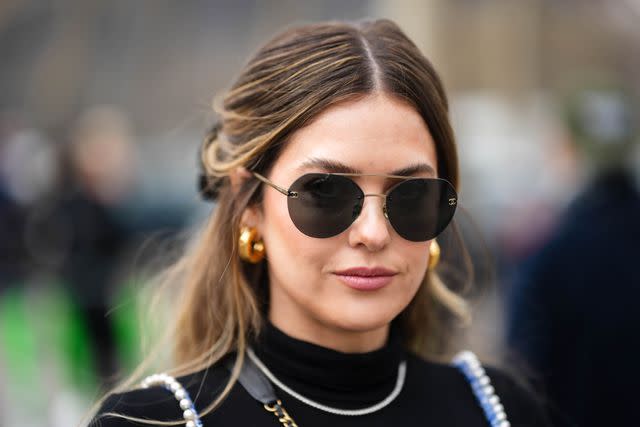
Getty Images
Given its origins as part of the standard-issue American Air Force uniform, it’s no surprise that aviator sunglasses are the most enduring, vintage style of the bunch. Characterized by a metal frame with teardrop-shaped lenses and a double bridge, the design is timeless, and versatile, and suits various face shapes, which, according to Dr. Tsai, make them a popular choice for all genders.
Additionally, Cantell points out that aviator sunglasses are one of the most iconic accessories ever to be embraced by the celebrity set. “They’re synonymous with Tom Cruise as the all-American rebel in Top Gun — but let’s not forget the equally iconic style of Bianca Jagger or Stevie Nicks, or Brad Pitt anytime he and his blond highlights went near a red carpet with Jennifer Aniston,” shares Cantell. “Spinoff styles like the Ray-Ban Shooters (with that circular detail between the brows that’s perhaps not accidentally the exact fit for a cigarette) are cemented in our collective memories thanks to Fear and Loathing in Las Vegas, but it’s the blue-lensed pair favored by Gloria Steinem that live rent-free in my head,” she admits.
Today, Cantell recommends aviator sunglasses with faux tortoiseshell frames and lighter lenses. “Personally, I’m a sucker for a more angular pair of gold aviators — Bottega Veneta and Celine’s current offerings are truly perfect, although the latter might have an edge thanks to the removable leather neck cord I didn’t know I needed,” she confesses. No matter what version of aviators you purchase, they’re guaranteed to be stylish for decades to come.
The Wayfarer
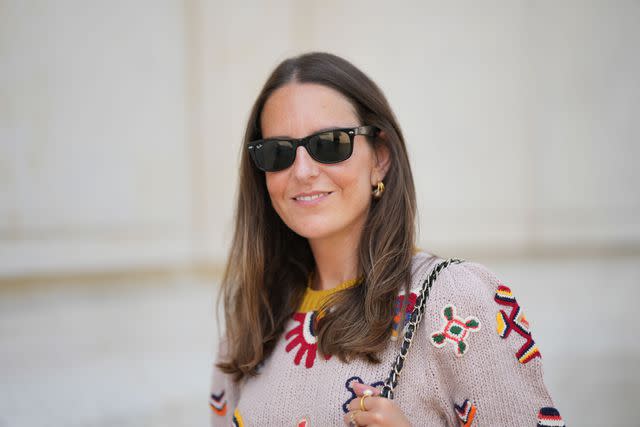
Getty Images
Looking for something a bit more current? Allow us to introduce you to The Wayfarer, another Ray-Ban-born classic. Cantell calls this style the “Cadillac of eyewear,” which traces its roots to the 1950s and quickly became as recognizably mid-century modern as the Eames chair. Traditionally, Wayfarer sunglasses feature a slightly trapezoidal frame made of plastic in various colors and include dark, rectangular lenses. “These iconic, unisex sunglasses offer both style and UV protection, making them a popular choice for many,” shares Dr. Tsai.
Again, we can attribute the rise in popularity of Wayfarers to memorable moments in popular culture, but in this case, the style truly attained icon status 30 years after its original debut. While superstars of the ‘50s like Marilyn Monroe and Muhammad Ali sported these frames, Cantell credits the teen movies of the 1980s for truly popularizing the simple style. “Amidst that slew of John Hughes coming-of-age films, Wayfarers became a nod to the being one of the cool kids: the new leather jacket,” she explains. “Anthony Michael Hall wore them when he smoked with Judd Nelson in The Breakfast Club. Matthew Broderick smugly smiled at you over his Wayfarers as Ferris Bueller, as did Tom Cruise, the original eyewear influencer, in Risky Business,” Cantell professes.
As a result, there are endless options for Wayfarers to shop today, no matter your budget. Pick up a pair of cheap frames and don’t feel bad about losing them, or splurge for a designer pair that will last you for ages — provided you keep them within eyesight at all times.
The Cat-Eye
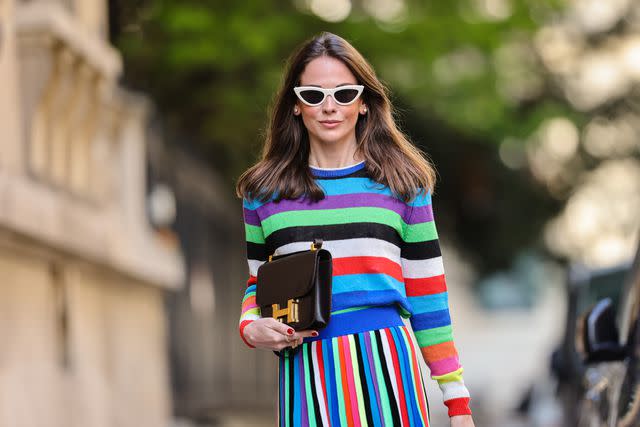
Getty Images
Perhaps the most easily recognizable style of the bunch, cat-eye frames were the first style of eyewear ever designed specifically to make women feel like babes, according to Cantell. “American artist and designer Atlina Schinasi was reportedly sick of the whole 'men don’t make passes at girls who wear glasses' vibe, so she created her 'Harlequin' frames using masquerade masks as inspo,” she explains.
Cat-eye frames have morphed over the decades, with some pairs looking more angular (see: Anouk Aimée in La Dolce Vita) or rounded (Audrey Hepburn’s iconic shades in Breakfast at Tiffany’s). Cantell’s favorite pair is those worn by Julia Roberts in Notting Hill. “Roberts wears a much more understated cat-eye with her leather blazer and black beret, but the look still gives that undercover movie star energy,” she explains.
Today, cat-eye sunglasses are classified as a retro-inspired style with upswept, pointed outer edges resembling the upturned curvature of a feline’s eyes. “They have oversized lenses, a feminine appeal, and add a vintage touch to any outfit,” Dr. Tsai points out.
The Round
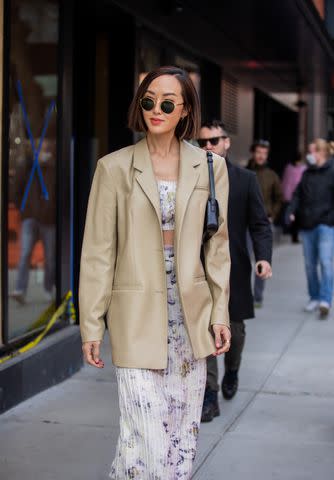
It doesn’t get more ‘90s than perfectly round wire-rimmed sunglasses. The minimalist style was featured on faces everywhere in America, including on-screen at Melrose Place and Beverly Hills, 90210.
These shows in particular influenced Cantell as a kid growing up halfway around the world in New Zealand. “The first sunglasses I remember coveting were gold and round-framed,” she gushes. “They were the coolest sunglasses in the entire world, as proven by everyone that mattered to me at the time: Lisa Bonet, Drew Barrymore, George Michael, and even Princess Diana (in her post-divorce era),” she recalls.
While super simple in appearance, Dr. Tsai says there are a few characteristics that help to make round sunglasses a stand-out signature style. “The form is closely related to the browline style, differentiated by having an upsweep at the outer edges where the temples or arms join the frame front,” she explains. And, while it’s the wire metal rims that continue to captivate most audiences (think: John Lennon, Janis Joplin, and Penny Lane from Almost Famous), acetate styles have ebbed and flowed in popularity thanks in part to their superior durability.
Tips
Notably, both Dr. Tsai and Cantell agree that round sunglasses don’t always look best on round-shaped faces.
The Oversized
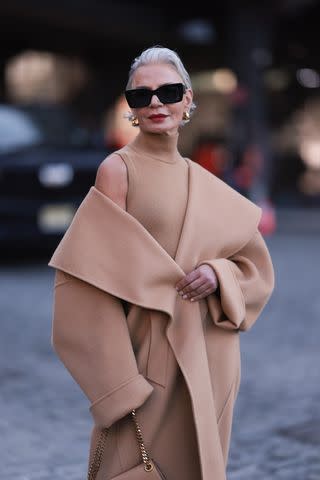
Getty Images
Despite the moniker, oversized sunglasses are not one-size-fits-all. Since the style comes in so many variations in shape, material, and proportions, it’s important to try on a bunch of oversize frames to know what look fits your face best. For instance, if you have retro or mod style icons like Twiggy, Peggy Lipton, and Jackie Kennedy on your mood board, you’ll want to seek out in giant, “bug-eyed” frames. Similarly, Cantell credits Jane Birkin’s blue-tinted tortoiseshell frames in La Piscine as one of the major pop culture moments to put oversized sunglasses on the public’s radar.
From a practical perspective, Dr. Tsai favors oversized sunglasses due to the added protection from the sun. “Since they cover more skin on your face than normal-sized sunglasses, more surface area is protected from the sun’s UV rays,” she explains. Oversized shades can also make your nose appear smaller if that is a concern.
Larger-than-life sunglasses had a major resurgence in the early 2000s, with fashionable stars like the Olsen Twins, Lauren Conrad, and Marissa Cooper from The O.C. routinely covering a third of their faces with truly gigantic frames. “I was one of the many proud twenty-somethings in New Zealand who owned notoriously enormous Karen Walker eyewear as it went global, and I felt very fashionable,” confesses Cantell.
And, we’d be remiss not to pay homage to the late Joan Didion who captivated part-time fashionistas and professional stylists everywhere in a 2015 eyewear advertisement for Celine. “That photograph of Joan Didion wearing oversized frames after a lifetime of championing statement styles is still the coolest thing I’ve ever seen,” Cantell says.
The Wraparound
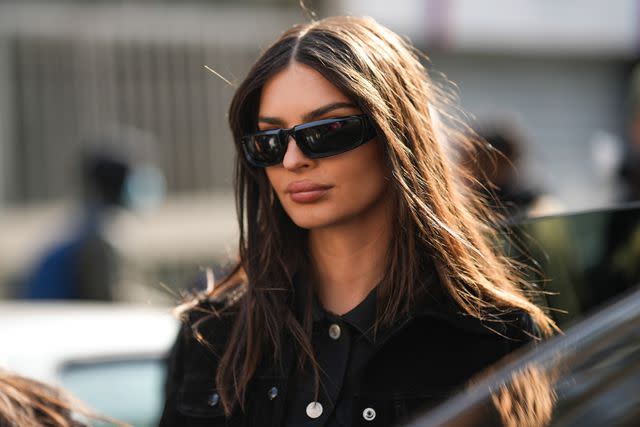
Getty Images
Wraparound sunglasses live in our heads (if not on our faces) rent-free. While many associate these sporty shades with the late 1990s, they first became popular in the 1960s after audiences became obsessed with the light gold wrap-around Ray-Ban Olympians worn by Peter Fonda in Easy Rider.
Different from other frames by their curved design, wraparound sunglasses provide extended coverage around the sides of the face, blocking wind, glare, and dust from all angles. And, although this style is popular for sports and outdoor activities, Dr. Tsai cautions that not all wraparound sunglasses accommodate prescription lenses, so be sure to ask your optician before falling in love with a pair.
Interestingly, the wraparound style took on its sportier flare in the ‘80s when athletic brands like Oakley got into the mix. “Traditional outdoor apparel designers went from making reflective goggles for sporty people to selling sunglasses that achieved the same thing,” explains Cantell. “The style caught on beyond just Tour de France cyclists and recreational skiers and became a deliciously obnoxious yuppie trend — complete with oily mirrored lenses — before the ‘90s even hit,” she shares.
The latest resurgence of the style can be attributed to a more fashion-forward crowd — think Rihanna, the Kardashians, and Gigi and Bella Hadid — who sport super-luxe designer pairs. But, that doesn’t mean you have to spend a fortune to achieve the outdoor recreational vibe. “After decades of being relegated to gas station displays, wraparound sunglasses have made a massive comeback,” notes Cantell. “There are some elevated takes on offer from the likes of Bottega Veneta, but cool kids with a love of ironic accessories will probably tell you that’s missing the point.”
Other Features to Consider
If you’ve read this far, then you’re probably ready to invest in your next pair of quality eyewear. In addition to finding the right frames for your face shape, Dr. Tsai suggests keeping the following tips in mind when shopping for any type of glasses:
If you have a strong prescription... The right frame shape not only depends on your bone structure but also on the strength of the prescription. For example, higher prescriptions work better in smaller and rounder frames, which tend to be lighter and can hide the thickness of the lens around the borders.
If you want more protection... Consider advanced lens technologies like polarized or photochromic lenses. This will help you to achieve the best sun protection — and therefore eye protection — possible. Also, Don’t skip out on the UV protection. Most standard plastic lenses, whether prescription, blue-light, or sunglasses, often lack UV protection. Dr. Tsai counsels her patients to always choose 100% UV protection lenses, which can come in the following forms:
Polycarbonate and high-index lenses offer some inherent UV protection.
Photochromic lenses darken in UV light, providing UV protection.
Polarized lenses reduce glare but vary in UV protection.
Consider fit over fashion. Yes, sunglasses are fun and stylish, but you’ll want to choose a pair that you will actually wear because trends come and go, but protecting your eyesight is something you’ll want to do forever.
See if the frames have a warranty. Glasses can be expensive, and accidents happen, so it is important to make an effort to seek out reputable brands with good warranties and customer service. Even if it costs a bit more upfront, the quality and protection against future loss, damage, or everyday wear and tear are worth it.
For more InStyle news, make sure to sign up for our newsletter!
Read the original article on InStyle.

